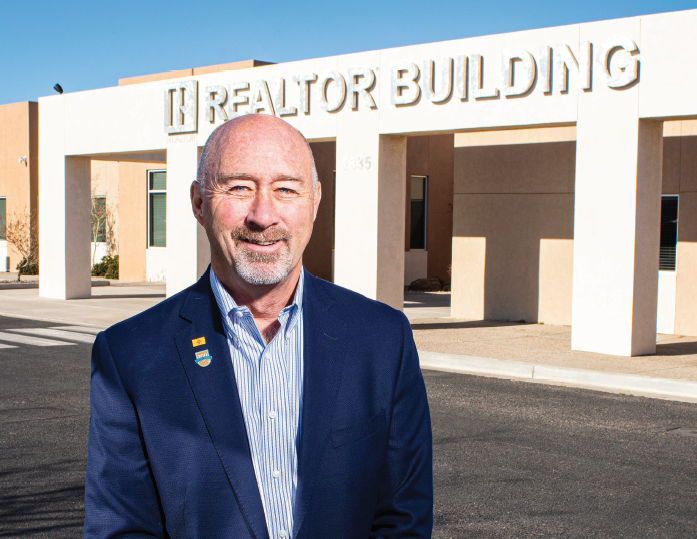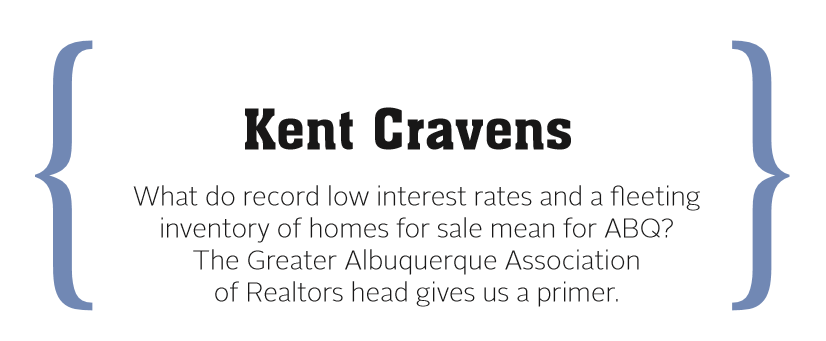
Up Close and Personal with our Leaders and Difference - Makers by Zane Beal
April 2021 | ALBUQUERQUE THE MAGAZINE
These days, the local housing market seems practically insatiable. According to the Greater Albuquerque Association of Realtors’ (GAAR) December market report, homes are spending an average of 21 days on market—twenty less than a year ago—with median and average detached home prices rising to $265,000 and $313,254, respectively. Those are increases of 17 and 18 percent over last year. Kent Cravens—a former New Mexico state senator, businessman, and current chief executive officer at GAAR—sat down to help us make some sense of these trends. Real estate, explains Cravens, is a powerful economic driver, supporting jobs and pumping an average of $80,000 into the local economy each time a home is sold. Celebrating their centennial anniversary, GAAR supports the efforts of regional realtors, and provides an invaluable hub for insight into the shape and future of the local market.
ATM: Can you give us an overview of what the real estate market looks like today compared to where it was a year ago?
KENT CRAVENS: Yeah. As a matter of fact, I was just looking through some of our more detailed stats. As you know, interest rates have been historically low for an extended period of time. That time that they’ve been so low doesn’t seem to have affected the appetite for people moving, purchasing, refinancing, building, and so forth. So I would have to tell you, it’s been pretty robust in spite of the lack of labor, materials, prices—all those things that had been standing in the way of the building really progressing. We’re still seeing the resale market being extremely robust.
ATM: During the course of your career, have you ever seen interest rates as low as they are right now?
KC: No, absolutely not. This is historically as low as they’ve been. Two and a half percent.
ATM: So what’s putting a damper on building?
KC: Our economist with the National Association of Realtors—his name is Lawrence Yun—and he’s been on the scene for quite a number of years being the chief economist for NAR. He says it’s the four L’s. It’s labor, of course—it’s hard to find people to do those jobs, especially when you’ve got projects like Facebook and, you know, the studios out north of town. All those things kind of gobbling up the available labor market. That presents an interesting dilemma for us. Lots—you know, Albuquerque has sort of built walls around itself with what we would perceive to be barriers, like mountains and rivers, that in other towns really aren’t barriers. But we’ve got an issue with available lots. Loans are a factor. I mean, you know, banks want to be paid back. And so they’re wanting people that can qualify to pay them back. Lumber, lots, loans, and labor. That’s it.
ATM: And these are the constraints that are preventing people from just building more and more new houses to meet demand?
KC: Right. I think if you talk to the Home Builders Association—I don’t know if you know John Garcia over there—he and I are constantly talking about what we can do to spur development, which really doesn’t help us out until the house, you know, becomes a resale. You know, builders will build and sell their own product and a lot of times don’t necessarily use a realtor for that. But the resale market, in order to continue to be healthy, will need some more inventory on the market. In 2009, we ended the year with 5,176 homes in our multiple listing service (MLS), which was considered even less than than a balanced market. A balanced market should be about 6,000 to 8,000 or 7,000 homes—somewhere in that range. We ended 2020 with 950 homes in the MLS. So you can see a dramatic reduction over the years in availability.
ATM: According to GAAR’s December 2020 market report, houses are sitting on the market for an average of 21 days, as opposed to 41 days a year ago. Have you ever seen homes move that fast?
KC: No, not in my years in real estate. It is, again, unprecedented. Let’s say our average sales price now is $313,000 for a detached home. Let’s put that average home on the market. If it’s priced right, it will sell sometimes within hours in this market. Certainly within days, it can generate multiple offers if it looks good and it’s priced right.
ATM: What does it mean for a property to be priced right?
KC: One of the issues people run into is when they price a home too high, the bank will come back if they find a buyer that needs a loan to get the home, which most do. There’s some cash deals out there—probably more now than I’ve seen in my years in real estate—but the banks just need an appraisal to back up their investment in that property. So if the appraisal doesn’t come in at $313,000, if it’s something less than that, a few things [might] happen: One, the buyer comes up with the money for the difference somehow. Maybe the seller lowers the price, if they’re motivated to sell, or it may be a cash deal. Or they just have to terminate the purchase agreement. And that’s been happening some when these homes don’t appraise for the value that’s been offered. But there’s a lot of multiple offer situations happening on a daily basis these days.
ATM: Are homes being purchased locally or are people coming in from out of state?
KC: You know, I think there’s some evidence to show that there is some in-migration, in terms of that, and I think it may have something to do with our market being favorable in several ways. Number one, just affordability compared to California, Chicago, New York, Florida. It’s more affordable to live here, in most ways. Even the price of our gasoline is substantially lower than some of those markets. Taxes are another big reason people are moving from metropolitan areas larger than Albuquerque—to be in a favorable spot. The fact that you and I are doing what we’re doing right now, on this zoom call. People are working from home and they’re able to pick and choose.
ATM: Are people targeting any neighborhoods here more than others?
KC: You know, the neighborhoods really haven’t changed that much. It’s Northeast Heights, because of land availability, and the Westside, back to Unser Boulevard and points west of that. Sandoval County is gaining favor and of course, Valencia County is becoming a lot hotter market than it’s ever been before. Realtors down in Valencia County have never seen a market like they have today.
ATM: Has there been any increase in the number of people trying to get into the real estate profession?
KC: We’ve seen an uptick. When I came onto GAAR five years ago, we had a little over 3,100 members. We just finished out the year with over 4,200 members in GAAR. So we’ve grown by 20% a year if you average it out and there’s no end in sight. We have new members showing up all the time. I think the perception is that it’s a good time to get into real estate. And it may be, but we finished December with 866 detached homes in our listing base, which is not even one per member. And therein lies the magic. Realtors need to learn how to generate leads and develop their pipeline so that they have a pipeline of business to rely on throughout the year. But we have seen an increase in member volume, yes.
ATM: With more and more agents out there competing, is the job itself becoming harder for individual agents?
KC: You have to be a good realtor. In order to compete, you have to be innovative, you have to be attentive, you have to be professional people. Obviously sellers have choices when they’re selling now and a lot of times—and I say this in jest— but you know, being a realtor these days is not that big haired lady that wears too much perfume that your mom introduced you to, you know, that’s not who you’re going to sell your house with these days. It’s going to be somebody that you’ve vetted, that you’ve seen in the marketplace. A lot of times, it’s a relationship-based transaction. And so you develop relationships. And if people know, like, and trust you, they’re more likely to at least give you a shot at their business. And so if you can prove to them that you can get their house sold in the least amount of time for the most amount of money with the least amount of hassle, you stand a pretty good shot at getting a client.
ATM: To the layperson, this looks like a very favorable market for selling your home. Are there any sort of pitfalls that sellers need to keep in mind, even though things look great?
KC: Yeah, you better have a place to live [laughs]. If you don’t have a place to go, that’s gonna be a challenge. But, you know, there’s always pitfalls in a real estate transaction. Not that we mean for there to be, but it’s a very complex transaction. And, you know, a realtor’s job is to make sure that expectations are understood on both sides of the transaction. That’s what makes the multiple listing service (MLS) such a unique marketing tool, or a venue for transactions, is that there’s an agreement there that they will cooperate to get the transaction done. There’s two premises to the MLS. One is compensation. Obviously, realtors want to be compensated for the work they do. And the other is cooperation. But cooperation has to happen before the compensation can be realized.
ATM: Right now, interest rates are expected to remain pretty low for a while. How do you think that’s going to play out over the next few months, or maybe even the next year?
KC: With detached homes being at $313,000, on the average, you’re starting to catch up with what a builder has to pay to get a house out of the ground and what he has to charge for a house to put it on the market. Everything right now is pushing prices up—low interest rates, low inventory, high demand, and questionable future in terms of available property and so forth to build more homes in our area. Those are all pushing that price up. And as the average price of a resale starts to catch up with that $360- to $400,000 price that a builder has to charge for a new home of the same size, I think we’re going to see a lot more building, a lot more creative ways for builders to get out there and either do infill or replace some neighborhoods, maybe. I mean, I don’t know how all that’s gonna work. I know there’s some projects—Santolina out on the west side—[that] could be a huge project for Albuquerque in the future. There are a lot of available lots that can be scheduled out there and pretty quickly ramped up.
Source: "Albuquerque The Magazine"












Comments